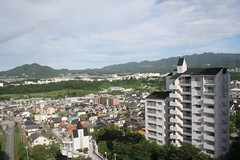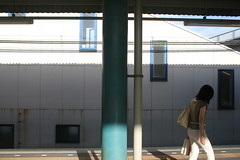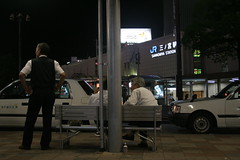
The first set includes pictures of my new apartment and the wonderful view from its 12 floor windows. In this set is a pic of my new cell phone. There is a pick of the elevator building. The mansion complex I live in now is on the top of the hill and the developer put in an elevator (accessible my the door key) so people don’t have to hike up the stairs on the way to the train station. And lastly, there is a pick of my super cool futon!

The second set includes pictures of, and around Taoji station the area I live in. Taoji is on the slow, old Shintetsu line that runs from Sanda in the hills behind Kobe to Shinkaichi in western Kobe.

The third set includes pictures I took in Sannomiya on the way home.
7 comments:
dave. i officially hate you. you are so lucky to be back there. i am looking at the jet program's CIR position, and i might be back in japan soon. we'll see.
I like you pictures of the decorated subway. They're fun. Been on any really wacky ones? Your part of town looks lovely (and fancy!) I like the couple pictures of people that you have, but oppositely I am intrigued that (in a country reknowned for population density) that you can take such nice unobstructed shots of subway terminals, escalators, elevators, stairwells, and the like. Really, it is characteristic of your Japan photos. It kind of tells the story, as far as I can tell, of the strucutual and designed elements that the hold the society together and keep it performing.
Come to think of it, depopulated places, alive or extinct, has been the characterizing feature of all your photography. And you've defined your photographic interests as such, documentation of sorts, treating ones own memory as a trust fund and photographs as security bonds. Sometimes its a relief to know that your lens is drawn to a particular thread and that you are creating a narrative simply by preferring one aesthetic over another. This is so apparent in your "Alta California" work where desolation is blatant. Perhaps, recognizable, by me and few others that know you too well, in your pictures of Japan.
Allowing yourself to shoot what feels natural and relevant to you, removes the agonizing effort to organize the random, which I tend to think is false storytelling.
Thanks for the great feed back Hannah, I donno I rarely 'think' about taking photos. I explore if that makes sense. However, I am actively trying to take more photos with people in them.
Sanda-city and the north ward of Kobe-city 20 years ago was rather rural, in Japanese standards of course, during the bubble many people seeking larger houses and good schools fled into the hills, making some poor landowners into the newly rich and changing the landscape drastically. Since the bubble some of the less wise building ventures have turned into vacant lots, mostly in in the old parts of town it seems. Never-the-less it is an aspect of the Japanese landscape not to be ignored.
Are the vacant lots eventually recycled, commercially or something? Do you think gentrification occurs the way we can see it in the states (hell,even here in central Beijing, by corporate rich Chinese and Expats)? I imagine (not knowing anything about Japanese cities) that there is more of a homogenous economic class (not to mention ethnic)structure there, perhaps capital investment moves more slowly cross the landscape, less driven by real estate trends and flux between suburban and urban, like we see in the states (the downtown is hip now).
Are any of these assumptions valid?
---Are the vacant lots eventually recycled, commercially or something?
Donno, let’s find out... I’ve only really glanced around the old town part of Sanda (Sanda Honmachi 三田本町) These buildings look like their waiting for new tenants.
---Do you think gentrification occurs the way we can see it in the states (hell,even here in central Beijing, by corporate rich Chinese and Expats)?
No. Lot of it has to do with the laws governing land ownership. Many people own a house, but not the land its built on. Also, houses in Japan are often replaced on a 30-50 year cycle. Change is constant.
---I imagine (not knowing anything about Japanese cities) that there is more of a homogenous economic class (not to mention ethnic)structure there, perhaps capital investment moves more slowly cross the landscape, less driven by real estate trends and flux between suburban and urban, like we see in the states (the downtown is hip now).
One of the biggest falsehoods the Japanese tell themselves is that they are all generally middle class. Maybe a few rich, but definitely no poor (and where to immigrants--like me--fit into that picture). People move location less in Japan, I have a friends who grew up, went to college, got married, and will probably live out the rest of their lives with in a 30 km radius. The place I live in is odd because it is like urban overflow. Like they truly packed in as much as they could into Kobe, if you go to the tower you’ll understand, and people needed places to live... The temporary capital influx of the 80’s and mid-90’s allowed this to be built... Now its chilling as is. The old is hidden and the new is gloriously bedroom community bland. I need to explore more.
---Are any of these assumptions valid?
Don’t know for sure.
thanks David. you've got interesting incites, and I like hearing them!
Post a Comment